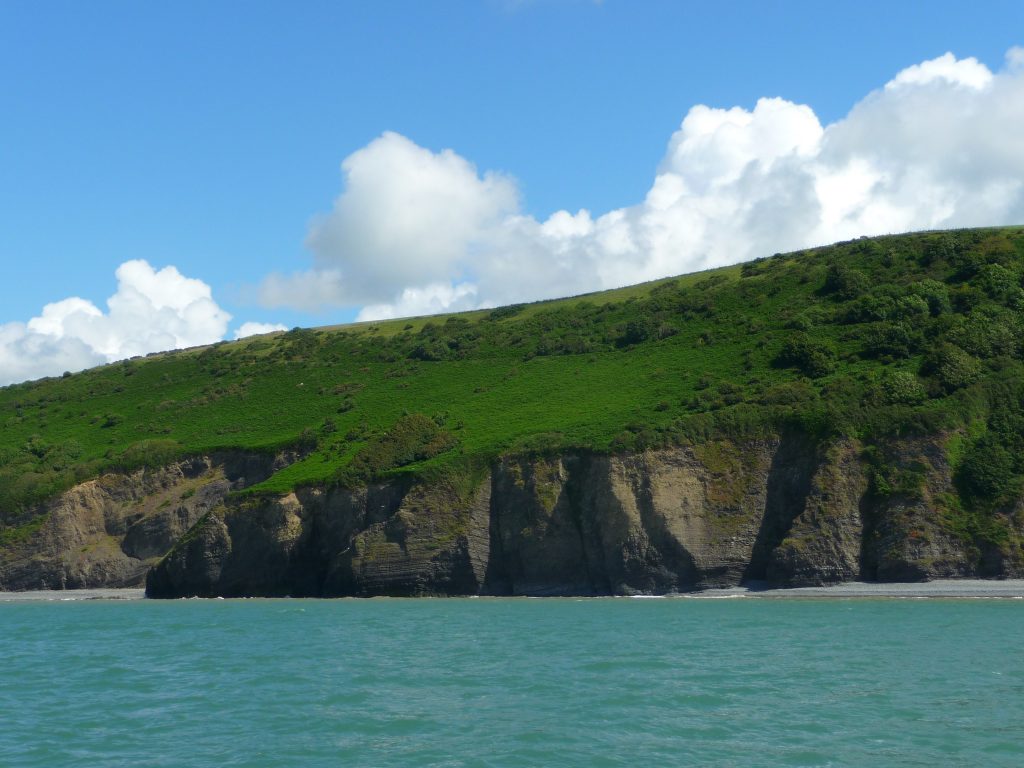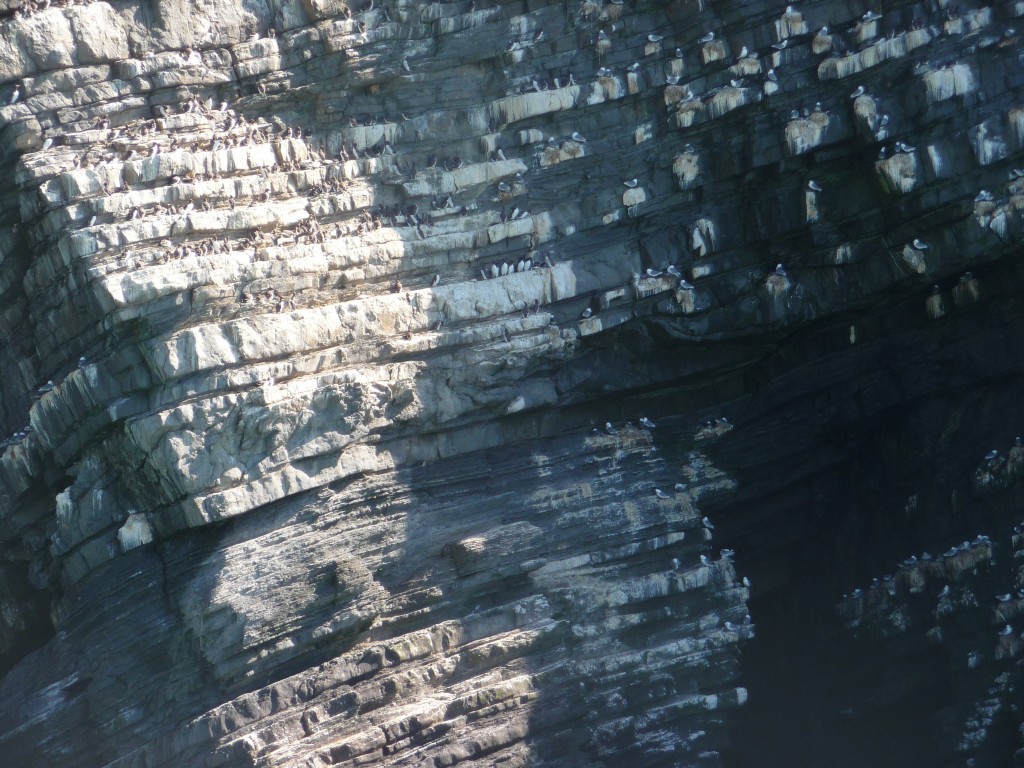Not far from St. Brides Bay there are two very small, interesting islands. These are both known to be home to many marine creatures. When migrating, they periodically live on these islands.
The surroundings waters are their personal space, where disturbance and danger should be far from them. The whole area, in fact is protected and the animals are safer for it.
The protection of marine wildlife is a complicated topic, which passes through different layers of legislation, in Wales, the UK and in Europe. It is not easy to show the importance of protected areas and make this as a compelling issue to everyone else. To assign a practical value to it has been the solution for some of the people involved in the protection and preservation of coastal biodiversity.
Paul Renfro, Sustainable Recreation Coordinator for the Pembrokeshire Coastal forum, says “We have done some economic evaluation studies of what the value of recreational tourism is in Pembrokeshire and Wales. What a politician at the time is very keen about is job growth, economic growth and money but how you change that as the environment actually provides so many jobs and create so much money and by damaging it is going to prevent in your growth of an industry. I think it is just a communication level but it is very important.”
The idea of evaluating nature to make it a bigger issue in the political agenda is believed to be a good way to tackle important problems sooner.
“From a personal perspective all the government cares about is the economy, and money. You’ve got to talk on those terms. So if you look at the EU Referendum for example, the environment is barely featured in this debate. It’s not a voting priority for people because all the media and all politicians talk about is money and immigration status,” says Lucy McRobert who collaborates with the Wildlife Trust and is the creative director of the program ‘A focus on nature’.[2]
“There is a huge environmental argument out there and what we have to do as conservationists is to talk to people in the language that they understand. And this means we have to talk in a monetary sense but always with wildlife being a primary driver so the money never becomes the main thing,” she says.[3]
To make this problem as a main concern, conservationists are trying to make people feel more involved by showing how nature has a direct connection to their own lives nature has a direct connection to their own live. However with the new situation faced by the UK, just after the exit from the European Union (Brexit), the future of projects financed by the EU is now unclear as well as what will happen to Marine Protected Areas under European legislation.
“The Special Areas of Conservation are a very interesting problem because essentially it is a European designation and obviously we have got the referendum coming up. It is going to be a very difficult thing to deal with if we leave the EU, which I sincerely hope we don’t, if we do it’s one of the huge problems we are going to face because conservation is going backwards in the UK enormously. Because we don’t have legislation other than European legislation to cover it,” says Paul Kay, underwater photographer and collaborator with the Marine Conservation Society (MCS).[4]
The current situation for marine wildlife in UK sees different types of Marine Protected Areas (MPA), given different levels of protection. Only two of these types of areas are under European legislation, the Special Areas of conservation (SACs) and the Special Protection Areas (SPAs).[5]
Since 2009 the Marine and Coastal Access Act created another kind of MPA, the Marine Conservation Zone (MCZ). The idea of this is to protect wildlife in inshore and offshore waters.
However a designated MCZ doesn’t stop activities like fishing nor will it restrict it. In fact it is written in the report ‘Establishing fisheries management measures to protect Marine Conservation Zones’ in 2010 by the Join Nature Conservation Committee (JNCC) that, ‘Some species, habitats and features protected by the MCZs are not sensitive to fishing activities and in these cases changes to fishing activities will not be needed’.[6]
In 2016 the JNCC reported that, ‘The management measures required within the Marine Conservation Zones (MCZs) will be decided on a site-by-site basis and it will depend on what the site has been designated for.’ It goes on to say that, ‘MCZs may have seasonal restrictions on activities rather than complete ban.’[7]
(please double click the picture and when it opens, click it again to zoom in and make it readable)
Cardigan Bay is designated as a SAC, where many species are protected but it is still possible to fish in different ways. One of these ways is scallop dredging. The topic is highly controversial and it is difficult to understand how conservation and dredging can coexist in the same place.
“They had a consultation about the scallop dredging in the SAC and if it should be allowed this past year.
There are lots of responses that scallop dredging and conservation shouldn’t be used in the same sentence. And I would encourage more people to think that and understand that a conservation area should be conserved and that doesn’t mean that fishing can’t happen but needs to be in a practice that needs to be considered by the industry. There is nothing about scallop dredging that is good for wildlife,” says Paul Renfro.[8]
The difficulty is about being sure of the consequences of similar activities but also checking that everyone dredging for scallops stays within the designated area.
“There is a study which has been done by the folks at Bangor University where they looked at an area that had been dredged and their study was basically saying through the years there is no detrimental effect. The study is true itself but it’s not looking at the long term ecosystem, it is not looking at places that have never been dredged, and reviewing years later. It doesn’t really show you the whole picture and it is only for a tiny area. If you say you can scallop in a SAC then what does it do to stop all the SAC being dredged?” says Kathy James, Sightings Officer at the Sea Watch Foundation.[9]
 A view of Southern Cardigan Bay. Since the time of writing, the Welsh Government have agreed to open up scallop dredging in areas of this SAC.
A view of Southern Cardigan Bay. Since the time of writing, the Welsh Government have agreed to open up scallop dredging in areas of this SAC.
Wales could see 34 new sites proposed to improve the degrees of protection inshore and 3 will be based offshore. This will help the health of wildlife and allows a better connection between inshore and offshore sites. One of the concerns present now is the degradation of existing sites considering that areas like the SAC doesn’t exclude or ban activities from the beginning.[11]
“The problem is you have some scallop dredgers who won’t stay within the allocated areas and will damage other areas. The MPAs do not exclude existing activities nor do they intend to do so. They are apparently intended to conserve the areas but also allow some activities to take place and they will always have a defection as a result,” says Paul Kay.[12]
Looking at the sea as a common resource, it is clear how it needs to be treated carefully in a way in which all the stakeholders will be allowed to sustain a healthy marine environment.
“Conservation above water, where we can see and visit, it is very different to underwater. Where for the majority it is a virtual world they see on photographs and in film or in descriptions. They never go to see it by themselves so I believe that the marine environment for most people is a concept,” says Paul Kay. “When you are telling people about conservation in the marine environment you are selling them something that is an idea not a reality. Which makes it very difficult because people don’t care much about concept because ultimately it is not real.”[13]
If you’d like some inspiration for reasons to support marine conservation zones, here are five!
Written & produced by Marta Montanari.
[1] Face to face interview, 12/07/2016, Pembroke’s Dock.
[2] Phone interview, 10/06/2016, Cardiff to University of Nottingham.
[3] Phone interview, 10/06/2016, Cardiff to University of Nottingham.
[4] Phone Interview, 21/06/2016, Cardiff to Anglesey.
[5] Anon Different Types of Marine Protected Area. 1st ed. Joint Nature Conservation Committee.
[6] Anon 2010. Establishing fisheries management measures to protect Marine Conservation Zones. 1st ed. JNCC.
[7] Anon 2016. Management of MCZs [Online]. Available at: http://jncc.defra.gov.uk/page-4884 [Accessed: 7 July 2016].
[8] Face to face interview, 12/07/2016, Pembroke’s Dock.
[9] Face to face interview, 13/07/2016, New Quay (Wales).
[11] Marine Conservation Society. Marine Protected Areas [Online]. Available at http://www.mcsuk.org [Accessed the 10 of January 2016].
[12] Phone interview, 21/06/2016, Cardiff to Anglesey.
[13] Phone interview, 21/06/2016, Cardiff to Anglesey.



























